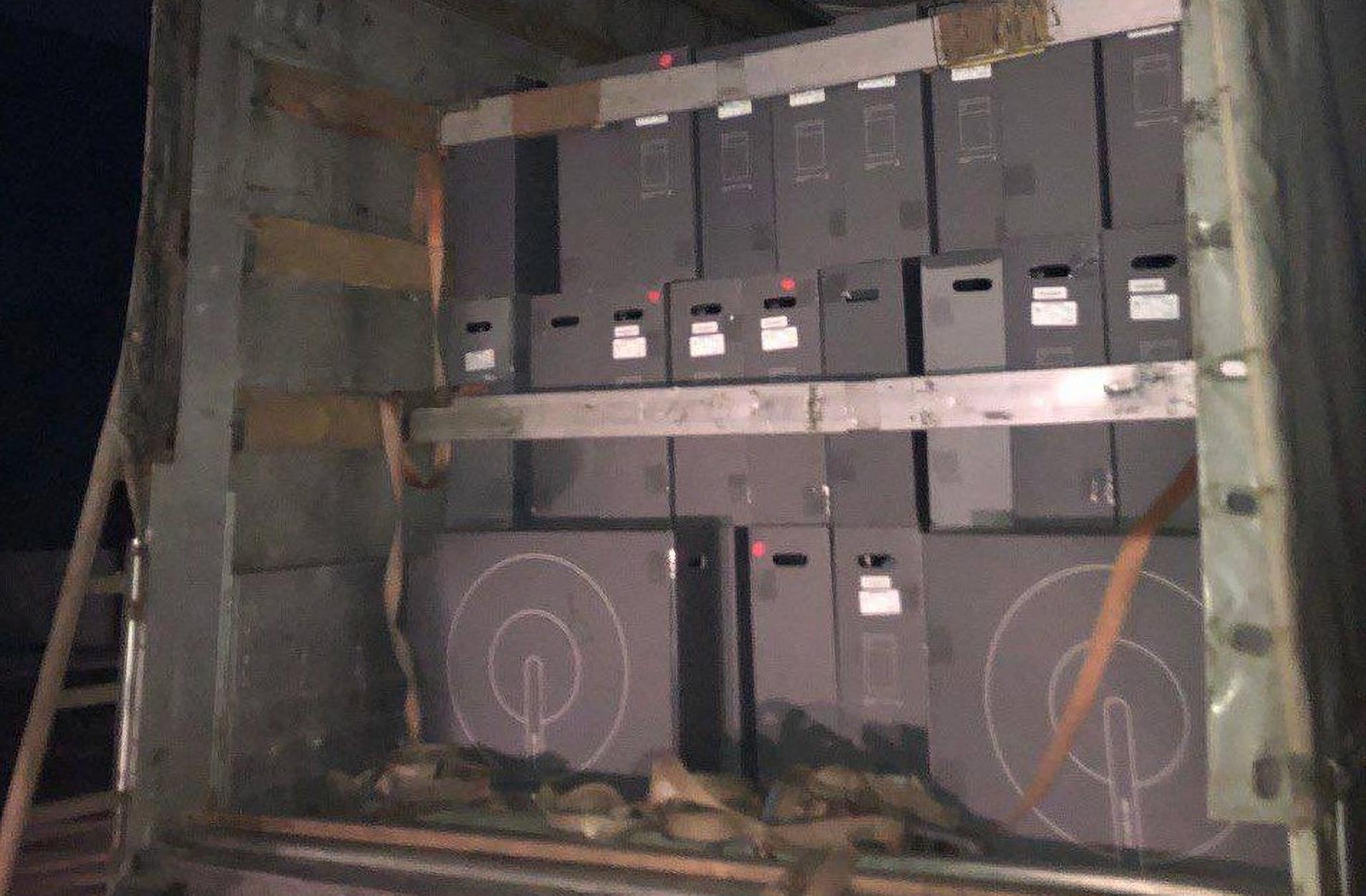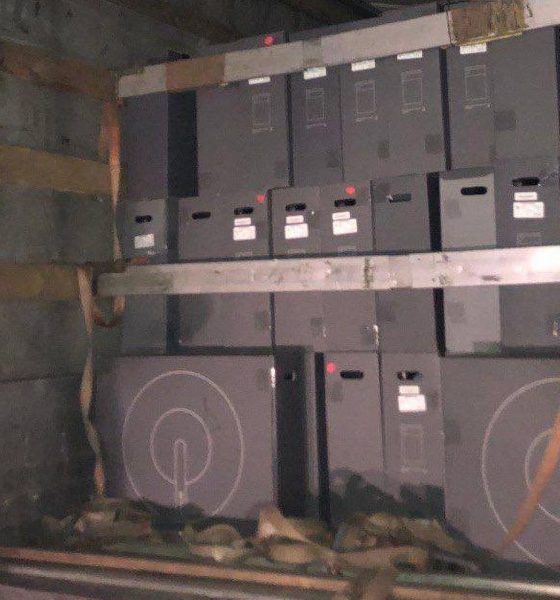

News
SpaceX delivers truckload of Starlink dishes to Ukraine, as promised
The Vice Prime Minister of Ukraine reports that a substantial truckload of Starlink dishes has arrived in the besieged country, fulfilling SpaceX CEO Elon Musk’s promise about 48 hours after his first exchange.
There are already reports from Ukrainians that the satellite internet service is up and running in the country. Packed with at least 100-200 dishes, SpaceX’s delivery will thus hopefully ensure that thousands or even tens of thousands of Ukrainians will be able to stay connected to high-quality internet in the event that Russia’s invasion begins to a larger toll on the country’s connectivity infrastructure.
It’s not entirely clear how SpaceX’s Starlink internet constellation will reach Ukraine, a country with no known ground stations. To function, an active Starlink satellite must simultaneously have a direct line of sight to individual user terminals (dishes) and a larger ground station. Communications from individual dishes travel up to a nearby Starlink satellite, which then routes those communications to a local ground station connected to the rest of the global internet. Due to a combination of physical limits and regulations designed to prevent interference, Starlink users must generally be within ~250 miles of a ground station to connect to use the service.
One such ground station located in central Poland might barely cover a sliver of Western Ukraine. Otherwise, the only explanation is that SpaceX is continuing a sort of unplanned field test that began with the island nation of Tonga and is attempting to connect Ukrainian Starlink users to distant ground stations using communications lasers installed on a new generation of satellites. Put simply, by using those “optical interlinks” to route communications in space, new Starlink V1.5 satellites can technically connect users anywhere on Earth – including war-torn regions where access to otherwise routine infrastructure is no longer safe or guaranteed.
The only challenge is that SpaceX only appears to have about 100 fully operational Starlink V1.5 satellites in orbit. More than 300 other V1.5 satellites are still slowly raising their orbits and could take weeks or months to reach operational altitudes. On top of the unproven nature of Starlink’s large-scale orbital laser network, it’s likely that the service will be intermittent, inconsistent, and far from reliable. Of course, when the alternative is nothing, any solution becomes a good option. It may also be the case that a series of ground stations in Poland, Lithuania, and Turkey collectively cover most of Ukraine, in which case the service will likely be excellent.
Regardless, Ukrainians will face two additional challenges with Starlink. First, the dishes require quite a lot of power to run. If internet infrastructure is suffering, it’s safe to assume that electricity distribution may also be in rough shape, meaning that users might have to get creative to use Starlink internet. Somewhat related to that challenge, there’s also a significant risk that Starlink dishes could become shiny bullseyes for antiradiation weapons if Russia were to start targeting communications. The country has done exactly that in past conflicts, which makes the use of any high-powered communications system inadvisable for anything more than short, intermittent use.
Regardless, Ukraine has shown extraordinary resolve in the face of a truly nightmarish situation and it’s safe to say that Starlink dishes will become another useful tool in the country’s arsenal as it continues to defend against a chaotic Russian invasion.

News
Elon Musk’s Grokipedia surges to 5.6M articles, almost 79% of English Wikipedia
The explosive growth marks a major milestone for the AI-powered online encyclopedia, which was launched by Elon Musk’s xAI just months ago.

Elon Musk’s Grokipedia has grown to an impressive 5,615,201 articles as of today, closing in on 79% of the English Wikipedia’s current total of 7,119,376 articles.
The explosive growth marks a major milestone for the AI-powered online encyclopedia, which was launched by Elon Musk’s xAI just months ago. Needless to say, it would only be a matter of time before Grokipedia exceeds English Wikipedia in sheer volume.
Grokipedia’s rapid growth
xAI’s vision for Grokipedia emphasizes neutrality, while Grok’s reasoning capabilities allow for fast drafting and fact-checking. When Elon Musk announced the initiative in late September 2025, he noted that Grokipedia would be an improvement to Wikipedia because it would be designed to avoid bias.
At the time, Musk noted that Grokipedia “is a necessary step towards the xAI goal of understanding the Universe.”
Grokipedia was launched in late October, and while xAI was careful to list it only as Version 0.1 at the time, the online encyclopedia immediately earned praise. Wikipedia co-founder Larry Sanger highlighted the project’s innovative approach, noting how it leverages AI to fill knowledge gaps and enable rapid updates. Netizens also observed how Grokipedia tends to present articles in a more objective manner compared to Wikipedia, which is edited by humans.
Elon Musk’s ambitious plans
With 5,615,201 total articles, Grokipedia has now grown to almost 79% of English Wikipedia’s article base. This is incredibly quick, though Grokipedia remains text-only for now. xAI, for its part, has now updated the online encyclopedia’s iteration to v0.2.
Elon Musk has shared bold ideas for Grokipedia, including sending a record of the entire knowledge base to space as part of xAI’s mission to preserve and expand human understanding. At some point, Musk stated that Grokipedia will be renamed to Encyclopedia Galactica, and it will be sent to the cosmos.
“When Grokipedia is good enough (long way to go), we will change the name to Encyclopedia Galactica. It will be an open source distillation of all knowledge, including audio, images and video. Join xAI to help build the sci-fi version of the Library of Alexandria!” Musk wrote, adding in a later post that “Copies will be etched in stone and sent to the Moon, Mars and beyond. This time, it will not be lost.”
News
Tesla Model 3 becomes Netherlands’ best-selling used EV in 2025
More than one in ten second-hand electric cars sold in the country last year was a Tesla Model 3.

The Tesla Model 3 became the most popular used electric car in the Netherlands in 2025, cementing its dominance well beyond the country’s new-car market.
After years at the top of Dutch EV sales charts, the Model 3 now leads the country’s second-hand EV market by a wide margin, as record used-car purchases pushed electric vehicles further into the mainstream.
Model 3 takes a commanding lead
The Netherlands recorded more than 2.1 million used car sales last year, the highest level on record. Of those, roughly 4.8%, or about 102,000 vehicles, were electric. Within that growing segment, the Tesla Model 3 stood far ahead of its competitors.
In 2025 alone, 11,338 used Model 3s changed hands, giving the car an 11.1% share of the country’s entire used EV market. That means more than one in ten second-hand electric cars sold in the country last year was a Tesla Model 3, Auto Week Netherlands reported. The scale of its lead is striking: the gap between the Model 3 and the second-place finisher, the Volkswagen ID3, is more than 6,700 vehicles.
Rivals trail as residual values shape rankings
The Volkswagen ID.3 ranked a distant second, with 4,595 used units sold and a 4.5% market share. Close behind was the Audi e-tron, which placed third with 4,236 registrations. As noted by Auto Week Netherlands, relatively low residual values likely boosted the e-tron’s appeal in the used market, despite its higher original price.
Other strong performers included the Kia Niro, the Tesla Model Y, and the Hyundai Kona, highlighting continued demand for compact and midsize electric vehicles with proven range and reliability. No other model, however, came close to matching the Model 3’s scale or market presence.
News
Tesla Model Y Standard Long Range RWD launches in Europe
The update was announced by Tesla Europe & Middle East in a post on its official social media account on X.

Tesla has expanded the Model Y lineup in Europe with the introduction of the Standard Long Range RWD variant, which offers an impressive 657 km of WLTP range.
The update was announced by Tesla Europe & Middle East in a post on its official social media account on X.
Model Y Standard Long Range RWD Details
Tesla Europe & Middle East highlighted some of the Model Y Standard Long Range RWD’s most notable specs, from its 657 km of WLTP range to its 2,118 liters of cargo volume. More importantly, Tesla also noted that the newly released variant only consumes 12.7 kWh per 100 km, making it the most efficient Model Y to date.
The Model Y Standard provides a lower entry point for consumers who wish to enter the Tesla ecosystem at the lowest possible price. While the Model 3 Standard is still more affordable, some consumers might prefer the Model Y Standard due to its larger size and crossover form factor. The fact that the Model Y Standard is equipped with Tesla’s AI4 computer also makes it ready for FSD’s eventual rollout to the region.
Top Gear’s Model Y Standard review
Top Gear‘s recent review of the Tesla Model Y Standard highlighted some of the vehicle’s most notable features, such as its impressive real-world range, stellar infotainment system, and spacious interior. As per the publication, the Model Y Standard still retains a lot of what makes Tesla’s vehicles well-rounded, even if it’s been equipped with a simplified interior.
Top Gear compared the Model Y Standard to its rivals in the same segment. “The introduction of the Standard trim brings the Model Y in line with the entry price of most of its closest competition. In fact, it’s actually cheaper than a Peugeot e-3008 and costs £5k less than an entry-level Audi Q4 e-tron. It also makes the Ford Mustang Mach-E look a little short with its higher entry price and worse range,” the publication wrote.








